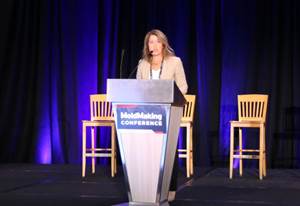Four-Step Formula for Mold Builders to Use in Their Marketing That Increases Sales
The most common marketing mistakes, some key marketing questions to land new business and how the Theory of Constraints applies to marketing within the small to midsize manufacturer.

One proven way to increase conversion rates is to get the prospect to seek you out and ask for help. Photo Credit: iStock
There are all kinds of approaches to sales and marketing. They all help to some extent, but they also leave much to be desired. What’s worse is that your customers are often more focused on sourcing the cheapest molds instead of maximizing their own throughput. It seems like some customers only care about the price tag, regardless of how well the mold works, how much it can produce or how long until it needs repair.
This leads many mold builders to focus on cutting costs (to lower prices and increase sales) or attempting any number of marketing approaches, hoping one of them might work. There’s no shortage of approaches, such as the “Industry 4.0/Social Media” approach, which suggests everything needs to be online and automated — from the receptionist to developing estimates for a new mold. Then there’s the “tried and true” approach of simply doing good work in the industry and letting word of mouth do the rest. There are also any number of methods in between these two approaches.
The problem is, none of these methods are as effective as we’d like. We all want to increase sales, but getting new customers can be a challenge. In fact, this is one of the top problems of many shops. According to a Marketing Sherpa study, if you have 100 opportunities, only four are likely to move from a “sales-ready lead” to a “qualified prospect” to an actual customer. Keep in mind that these numbers are based on “averages.” If you have a more technical sale (which, selling moldmaking services certainly is), the higher quantity and quality of information transfer, the timing of the delivery and the method of that delivery can all lower the actual average prospect conversion rate.
The four-step formula puts you in the right frame of mind to focus on your prospects, their problem and a unique way or uniquely positioned way it might be solved.
Not only that, in moldmaking it also depends on who you’re dealing with as a customer because not everyone thinks molds are an asset, nor has the ability to increase the budget. For example, is it the toolroom manager? You may get some repair work sent your way, but they certainly aren’t going to approve a complete overhaul. Is it the general manager? They might approve some preventative maintenance (PM), if they’re an OEM (good luck with a custom molder), but it’s hard to get to them. Then, even if you reach the general manager, there’s no guarantee they’ll want to take the time to really understand how your offering might improve their business. Or, is it a buyer? If so, just forget about winning a job that could be profitable! You might as well be writing your customer a check for the “privilege” of working on their job.
From the outset, marketing efforts seem doomed on arrival. They’re either expensive, flashy or completely ineffective. On top of that, despite how solid your offer to your customer may be, you have an uphill battle just to get the customer to listen to how you can help their business make more money. That’s the bad news.
Increase Sales: Get Prospects to Find You!
Now here’s the good news. One proven way to increase conversion rates is to get the prospect to seek you out. How much do you love it when a customer or prospect comes to you with a complex problem and basically says “I need your help?”
Those are the best kinds of sales, jobs and customers, right? What makes this situation so great? It’s because if the customer was willing to ask for our help, they know enough about what you do that they think you have the expertise to help; and at some level, they already trust you. This means the normal conversion rates don’t apply. The customer is already “presold” to a degree, so you have a much higher likelihood of winning this business.
Think about all that is being communicated, just by the simple act of asking for your help:
- If you didn’t trust someone, would you ask them for help?
- If you didn’t think someone could help you, would you ask them for help?
No! So, if someone does ask you for help, then this is a really good thing. One of the key marketing questions (if you want more sales) is: How do I get more existing customers and new prospects to ask me for help on work I want to do, and that I’m qualified to do?

The “hope for solving the problem” is not your offer, but how/why your approach works. Photo Credit: Getty Images
How to Get Prospects to Say, “I Need Help”
Here’s the formula we use to elicit the “I need help” response:
-
Shine a light on the problem. (There needs to be a message-to-market match. If you’re targeting buyers, you might focus on a different problem than if you’re targeting the toolroom manager or general manager.)
-
Verify or validate the problem.
-
Show that it’s even worse than that. (Don’t exaggerate, be truthful in all of this.)
- Provide the light at the end of the tunnel.
And yes, for the Theory of Constraints (TOC) fans out there, you’ll notice that this is based partially on the TOC buy-in process. Step one would be equivalent to “Agree on the Problem” and step four would be equivalent to “Agree on the Direction of the Solution.”
Putting the Four-Step Formula to Practice in Moldmaking
Let’s go through this with an example. Let’s say that I build new molds for OEMs. Let’s also assume that shops that use the molds we build can typically reduce their downtimes by 50%.
-
What problems do your customers or prospects have that are significant, but that you can help solve?
Well, when molds go down it costs them a lot of money. A lot. It’s not uncommon for a molder to lose $10,000-$50,000 of production for every day they’re down. By the way, when do molds go down? (Hint: it’s not when they’re sitting in the toolroom.) Molds go down when they’re being used and are needed the most! So, reducing the probability and duration of downtime is of tremendous importance.
-
How can you verify or validate this problem?
The National Institute of Standards and Technology reports that U.S. manufacturers waste 25-65% of their capacity being “ineffective.” That’s a large portion of U.S. manufacturing capacity that is not productive.
We had to search for this statistic, but it wasn’t hard to do. Consider the power of having a government agency showing that what I’m writing about is important.
-
How is it even worse than that for your target market?
As with everything, some molders may have more downtime than others, but we know almost every molder will suffer from downtime at some point over the life of any particular mold. Molders rarely have the luxury of being able to take a mold down for PM, let alone justifying the cost of paying for the PM. When a mold is in service, it’s needed and can’t afford to be down. Once the mold is out of service, it’s “out of sight, out of mind.” Who wants to spend money on a mold they aren’t using (at this hot second)?
-
What kind of hope is there for solving this problem?
A number of mold builders are turning these statistics around and improving productivity using a proprietary process that eliminates downtime by taking advantage of … {fill in the how/why of what you do that will reduce or eliminate the above problem}.
The “hope for solving the problem” is not your offer, but how/why your approach works. The how/why reduces or eliminates the prospect’s problem. You might talk about how you design, build, monitor, service, maintain, repair or anything else you do that results in less downtime for your customers.

This formula puts you in the right frame of mind to focus on your prospects, their project and a unique way it might be solved. Photo Credit: Science of Business Inc.
Using the Four-Step Formula in Your Marketing
Did you notice that this article was written using the process?
- Shine a light on the problem — It’s challenging for mold builders to increase sales.
- Verify or validate the problem — Marketing Sherpa statistic: Only four out of 100 leads convert to sales.
- Show that it’s even worse than that — Various reasons why mold builders have it particularly tough.
- Provide the light at the end of the tunnel — the four-step formula.
Did we try to sell you anything? No, we just shared our unique approach. If you wanted help getting your customers to ask for help, might you request our help? The four-step formula puts you in the right frame of mind to focus on your prospects, their problem and a unique way or uniquely positioned way it might be solved. It can be used for generating content on your website, in your newsletters or any other marketing you’re doing. You could even change your on-hold music to talk about the common problem and your unique approach that can reduce or eliminate it.
The objective is to get existing customers and prospects to ask for help. Will everyone? No, of course not. But the best ones will (the ones that really relate to the problem) and they are much more likely to turn into a sale.
The Results
We are closing over 79% of the people who contact us for help. That means 79 sales out of 100 instead of four. And selling Velocity Scheduling System, Velocity Pricing System and Mafia Offer Boot Camp is not only a technical sale, but also a counterintuitive one. We’re not saying that you will close 79 out of 100 prospects that request help. However, if you generated your marketing materials with the objective of getting prospects to ask for help, could you get just a few more quality leads that result in sales?
Related Content
Editorial Advisory Board 2023-2026: Camille Sackett, Vice President of Sales and Marketing for Accede Mold & Tool
The 2023-2026 version of MoldMaking Technology's EAB features a new crew of industry professionals. Meet Camille Sackett
Read MoreMMT Chats: Mold Builder Shares “Raw and Real” Social Media Strategy
MoldMaking Technology Editorial Director Christina Fuges sits down with Murphy Forsyth, GM – Injection Molding and Director Of Marketing for Zero Tolerance LLC in Clinton Township, MI.
Read MoreMMT Chats: Injection Molds and Integrated Solutions Through Ambition and Innovation
Jordan Robertson, VP, Business Development and Marketing for StackTeck discusses various mold technologies to improve efficiencies in automation, cooling, lightweighting and sustainability.
Read MoreThe Role of Social Media in Manufacturing
Charles Daniels CFO of Wepco Plastics shares insights on the role of social media in manufacturing, how to improve the “business” side of a small mold shop and continually developing culture.
Read MoreRead Next
Constraint Management: How to Break a Roadblock
Learning how to get the most out of what your shop has today.
Read MoreAre You a Moldmaker Considering 3D Printing? Consider the 3D Printing Workshop at NPE2024
Presentations will cover 3D printing for mold tooling, material innovation, product development, bridge production and full-scale, high-volume additive manufacturing.
Read MoreHow to Use Continuing Education to Remain Competitive in Moldmaking
Continued training helps moldmakers make tooling decisions and properly use the latest cutting tool to efficiently machine high-quality molds.
Read More




















